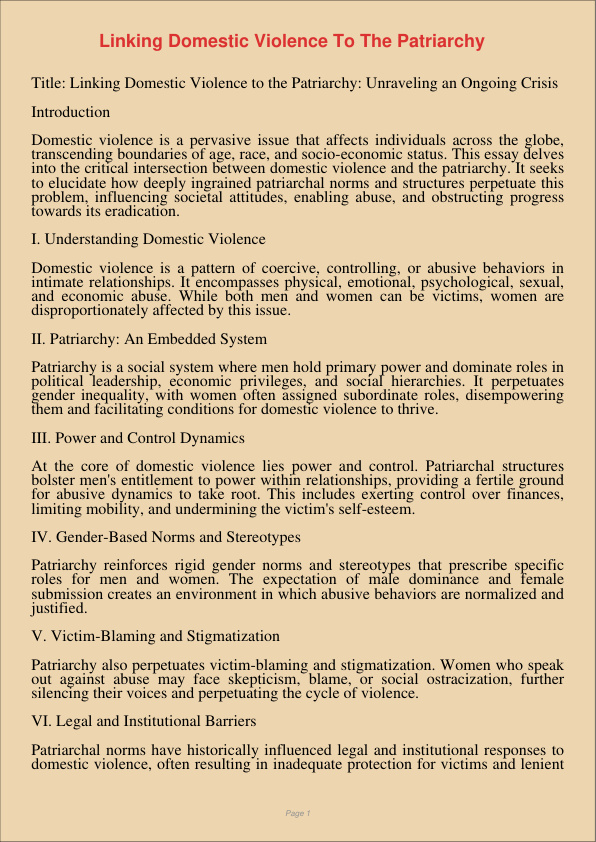Linking Domestic Violence To The Patriarchy
Jan 12, 2024
linking domestic violence
patriarchy
Geography
Literature
Title: Linking Domestic Violence to the Patriarchy: Unraveling an Ongoing Crisis
Introduction
Domestic violence is a pervasive issue that affects individuals across the globe, transcending boundaries of age, race, and socio-economic status. This essay delves into the critical intersection between domestic violence and the patriarchy. It seeks to elucidate how deeply ingrained patriarchal norms and structures perpetuate this problem, influencing societal attitudes, enabling abuse, and obstructing progress towards its eradication.
I. Understanding Domestic Violence
Domestic violence is a pattern of coercive, controlling, or abusive behaviors in intimate relationships. It encompasses physical, emotional, psychological, sexual, and economic abuse. While both men and women can be victims, women are disproportionately affected by this issue.
II. Patriarchy: An Embedded System
Patriarchy is a social system where men hold primary power and dominate roles in political leadership, economic privileges, and social hierarchies. It perpetuates gender inequality, with women often assigned subordinate roles, disempowering them and facilitating conditions for domestic violence to thrive.
III. Power and Control Dynamics
At the core of domestic violence lies power and control. Patriarchal structures bolster men’s entitlement to power within relationships, providing a fertile ground for abusive dynamics to take root. This includes exerting control over finances, limiting mobility, and undermining the victim’s self-esteem.
IV. Gender-Based Norms and Stereotypes
Patriarchy reinforces rigid gender norms and stereotypes that prescribe specific roles for men and women. The expectation of male dominance and female submission creates an environment in which abusive behaviors are normalized and justified.
V. Victim-Blaming and Stigmatization
Patriarchy also perpetuates victim-blaming and stigmatization. Women who speak out against abuse may face skepticism, blame, or social ostracization, further silencing their voices and perpetuating the cycle of violence.
VI. Legal and Institutional Barriers
Patriarchal norms have historically influenced legal and institutional responses to domestic violence, often resulting in inadequate protection for victims and lenient consequences for perpetrators. This systemic bias discourages victims from seeking help and justice.
VII. Social Change and Feminism
The feminist movement has been instrumental in challenging the patriarchy and its connection to domestic violence. It has raised awareness, influenced policy changes, and offered support for victims. By challenging traditional gender roles and advocating for gender equality, feminism has been a force for positive change.
VIII. Prevention and Education
Preventing domestic violence and dismantling the patriarchal structures that support it requires comprehensive educational programs. These programs should focus on challenging stereotypes, promoting healthy relationships, and empowering individuals to recognize and combat abuse.
IX. Empowering Survivors
Empowering survivors is a crucial aspect of addressing domestic violence. Support services, counseling, and safe shelters are vital in helping survivors break free from abusive relationships and rebuild their lives.
Conclusion
The link between domestic violence and the patriarchy is a complex and deeply rooted issue. Recognizing the role of patriarchal norms, stereotypes, and structures is fundamental to understanding why domestic violence persists in society. It is only by challenging and dismantling these systems and supporting survivors that we can hope to eradicate domestic violence and create a society that values gender equality, respect, and the safety and well-being of all its members. It is a collective responsibility to break the cycle of abuse and foster a more equitable, just, and compassionate world.
